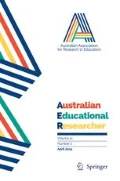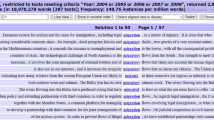Abstract
While an increasing body of Australian and international research has explored the relationship between media and education, few studies have examined this relationship in the context of early childhood education. This paper contributes to this research gap by reporting on a corpus-assisted discourse analysis of how childcare is represented in 801 newspaper texts from six Australian newspapers. As a foundational paper of a broader study investigating public and political influences on parents’ childcare choices, the paper details the use and utility of corpus linguistic tools for exploring the discourse construction of childcare in a large corpus of media texts. It also highlights the value of analysing media corpora via media ownership, focusing on the two dominant Australian media organisations, Fairfax and News Corp. Analyses reveal similarities but also key differences in the representation of childcare in Fairfax and News Corp newspapers. In Australia, print media still sets the daily media agenda and reflects the dominant discourse constructions surrounding major public issues. Accordingly, the beliefs, practices and decision-making of current and potential parent users of formal childcare may be differentially influenced depending not just on their (direct or indirect) access to print media, but by the format (tabloid or broadsheet) and thus ownership (Fairfax or News Corp).

Similar content being viewed by others
Notes
A significance value of p < 0.001 denotes that there is less than a 1 in a 1000 chance that the difference in a word's frequency in the focal corpus relative to the reference corpus is merely a chance occurrence, so the word’s use can safely be taken to characterise and differentiate the discourse of the focus corpus relative to that of the comparator.
A significance level of p < 0.05 (i.e. a less than a 1 in 20 chance of a difference being random) is typically taken as a minimum threshold for statistical significance. Anything greater than a probability of 0.05 is NOT statistically significant. Here the point is that we are looking for those words and phrases the frequencies of which do not even reach the threshold for significance when the two media sub-corpora are compared to one another. We use this as one of the metrics of ‘sharedness’: words and phrases that are shared are frequent in the total corpus and evenly distributed across the two media sub-corpora (to the point of NOT being keywords at the minimum acceptable level for significance in the cross-comparison).
The BNC is ‘a 100 million word collection of samples of written and spoken language from a wide range of sources, designed to represent a wide cross‐section of current British English, both spoken and written’ (Burnard 2009). Since no similar large, balanced reference corpus currently exists for Australian English, we deemed it appropriate to use the BNC. The written spelling and grammar of Australian English is much closer to that of British English than, say, American English. Moreover, since our aim is to identify the textual fingerprints of childcare-related newspaper articles as a body of texts, the only danger of comparison against the BNC is that it will also throw up Australia-specific dialectal differences and proper names in addition to the material we are most interested in.
References
Albanese, P., & Rauhala, A. (2015). A decade of disconnection: Childcare policies in changing economic times in the Canadian context. International Journal of Child, Youth and Family Studies, 6(2), 252–274.
Australian Bureau of Statistics. (2016). 4240.0—Preschool Education, Australia, 2015. http://www.abs.gov.au/ausstats/abs@.nsf/mf/4240.0.
Baker, P. (2004). Querying keywords: Questions of difference, frequency, and sense in keywords analysis. Journal of English Linguistics, 32, 346–359.
Baker, P., Hardie, A., & McEnery, T. (2006). A glossary of corpus linguistics. Edinburgh: Edinburgh University Press.
Baroutsis, A., & Lingard, B. (2016). Counting and comparing school performance: An analysis of media coverage of PISA in Australia, 2000–2014. Journal of Education Policy. doi:10.1080/02680939.2016.1252856.
Bell, A. (1991). The language of news media. Oxford UK: Wiley.
Blackmore, J., & Thomson, P. (2004). Just ‘good and bad news’? Disciplinary imaginaries of head teachers in Australian and English print media. Journal of Education Policy, 19(3), 301–320. doi:10.1080/0268093042000207638.
Blackmore, J., & Thorpe, S. (2003). Media/ting change: The print media’s role in mediating education policy in a period of radical reform in Victoria, Australia. Journal of Education Policy, 18(6), 577–595. doi:10.1080/0268093032000145854.
Brown, C., & Wright, T. (2011). The rush toward universal public pre-K: A media analysis. Educational Policy, 25(1), 115–133.
Burnard, L. (Ed.). (2007). Reference guide for the British National Corpus (XML edition). http://www.natcorp.ox.ac.uk/docs/URG/.
Burnard, L. (2009). What is the BNC? http://www.natcorp.ox.ac.uk/corpus/index.xml.
COAG. (2009). National partnership agreement on the national quality agenda for early childhood education and care. http://www.federalfinancialrelations.gov.au/content/npa/education/early_childhood/quality_agenda/national_partnership.pdf.
Cohen, J. L. (2010). Teachers in the news: A critical analysis of one US newspaper’s discourse on education, 2006–2007. Discourse: Studies in the Cultural Politics of Education, 31(1), 105–119. doi:10.1080/01596300903465450.
Dalton, B., & Wilson, R. (2009). Improving quality in Australian childcare: The role of the media and non-profit providers. In D. King & G. Meagher (Eds.), Paid care in Australia: Politics, profits, practices (pp. 203–230). Sydney: Sydney University Press.
Degotardi, S., Sweller, N., Fenech, M. & Beath, A. (under review). Influences on parents’ childcare choices: A comparative analysis of preschool and long day care users. International Journal of Early Childhood.
Dorfman, L., & Woodruff, K. (1999). Childcare coverage in U.S. newspapers (Issue 7). Berkeley Media Studies Group. http://www.bmsg.org/sites/default/files/bmsg_issue7_child_care_coverage_in_us_newspapers.pdf.
Fairfax Media. (2014). Brisbane Times audience persona. http://adcentre.com.au/wp-content/uploads/BT-Audience-Persona.pdf.
Fenech, M. & Sweller, N. (in press). Problematising Australia’s Nanny Pilot Program as evidence-based policy: A reconstruction of the problem of child care. Australian Journal of Social Issues.
Fowler, R. (1991). Language in the news: Discourse and ideology in the press. London: Routledge.
Hayden, J. (1996). Beyond Mr Bubbles: An analysis of the public image of early childhood care and education in Western Sydney. Journal of Australian Research in Early Childhood Education, 4(1), 65–76.
Johnston, J., & Graham, C. (2013). Shifting patterns in Australian newspaper writing styles: Results of a longitudinal study. Australian Journalism Review, 35(2), 118–131.
Kunkel, D., Smith, S., Suding, P., & Biely, E. (2002). Coverage in context: How thoroughly the news media report five key children’s issues. Commissioned by the Casey Journalism Center on Children and Families. Casey Journalism Center on Children and Families, University of Maryland, College Park.
Lonne, B., & Gillespie, K. (2014). How do Australian print media representations of child abuse and neglect inform the public and system reform? Child Abuse and Neglect, 38, 837–850.
McManus, J., & Dorfman, L. (2002). Silent revolution: How U.S. newspapers portray child care (Issue 11). http://www.bmsg.org/resources/publications/issue-11-silent-revolution-how-US-newspapers-portray-child-care.
Meagher, G., & Wilkins, D. (2012). How interests shape problem formulation in elder care reform: An Australian case study using corpus linguistics methods. In Paper presented at the conference of Research Committee 19 of the International Sociological Association, Oslo, Norway.
Mockler, N. (2013). Reporting the ‘education revolution’: MySchool.edu.au in the print media. Discourse: Studies in the Cultural Politics of Education, 34(1), 1–16. doi:10.1080/01596306.2012.698860.
Morley, J. (2009). Introduction: A description of CorDis. In J. Morley & P. Bayley (Eds.), Corpus assisted discourse studies on the Iraq conflict: Wording the war (pp. 1–11). New York: Routledge.
Nicholas, J., & Price, J. (1998). Advanced studies in journalism. Cheltenham: Thomas Nelson.
O’Connell, M., Fox, S., Hinz, B., & Cole, H. (2016). Quality early education for all: Fostering, entrepreneurial, resilient and capable leaders. Mitchell Institute policy paper No. 01/2016. http://www.mitchellinstitute.org.au/wp-content/uploads/2016/04/Quality-Early-Education-for-All-FINAL.pdf.
Penn, H. (2011). Policy rationales for early childhood services. International Journal of Child Care and Education Policy, 5(1), 1–16. doi:10.1007/2288-6729-5-1-1.
Potts, A., Bednarek, M., & Caple, H. (2015). How can computer-based methods help researchers to investigate news values in large datasets? A corpus linguistic study of the construction of newsworthiness in the reporting on Hurricane Katrina. Discourse & Communication, 9(2), 149–172.
Productivity Commission. (2015). Report on government services 2015: Child care, education and training (Vol. B). Retrieved February 10, 2015 from: http://www.pc.gov.au/research/recurring/report-on-government-services/2015/childcare-education-and-training/download-the-volume/rogs-2015-volumeb-child-care-education-and-training.pdf.
Richardson, B. (2011). A matter of choice: A critical discourse analysis of ECEC policy in Canada’s 2006 federal election. Occasional Paper No. 25. Toronto: Childcare Resource and Research Unit.
Richardson, B. (2015). Mass media, public opinion and policy (in)action: A meta-synthesis of literature examining childcare policy representation in Canadian newspapers in light of Habermas and Lippmann. In Paper presented at Media and Policy panel at 2nd international conference on public policy, Milan. http://www.icpublicpolicy.org/conference/file/reponse/1433867706.pdf.
Roy Morgan. (2015). Australian newspaper readership, 12 months to March 2015. http://www.roymorgan.com/industries/media/readership/newspaper-readership.
Scott, M. (1997). PC analysis of key words—and key key words. System, 25(2), 233–245.
Scott, M. (2012). WordSmith tools version 6. Stroud: Lexical Analysis Software.
Scott, M. (2015). WordSmith tools manual. Stroud: Lexical Analysis Software.
Sparks, C. (2000). Introduction: The panic over tabloid news. In C. Sparks & J. Tulloch (Eds.), Tabloid tales: Global debates over media standards (pp. 1–40). Oxford: Rowman and Littlefield.
Stack, M. (2006). Testing, testing, read all about it: Canadian press coverage of the PISA results. Canadian Journal of Education/Revue Canadienne De L Éducation, 29(1), 49–69. doi:10.2307/20054146.
Takami, S. (2004). A corpus-driven identification of distinctive words ‘Tabloid Adjectives’ and ‘Broadsheet Adjectives’. In J. Nakamura, N. Inoue, & T. Tabata (Eds.), English corpora under Japanese eyes (pp. 116–135). Amsterdam: Rodopi.
Taylor, C. (2013). Searching for similarity using corpus-assisted discourse studies. Corpora, 8(1), 81–113.
The Newspaper Works. (12 May, 2014). Total newspaper readership reaches a new high. http://www.thenewspaperworks.com.au/total-newspaper-audience-readership-reaches-a-new-high/.
Thomas, S. (2003). The trouble with our schools’: A media construction of public discourses on Queensland schools. Discourse: Studies in the Cultural Politics of Education, 24(1), 19–33. doi:10.1080/01596300303030.
Tiffen, R. (2011). Has the gap between qualities and tabloids increased? Changes in Australian newspapers 1956–2006. Australian Journal of Communication, 38(2), 33–52.
Tiffen, R., Jones, P. K., Rowe, D., Aalberg, T., Coen, S., Curran, J., et al. (2014). Sources in the news. Journalism Studies, 15(4), 374–391.
Ulmer, J. B. (2016). Re-framing teacher evaluation discourse in the media: An analysis and narrative-based proposal. Discourse: Studies in the Cultural Politics of Education, 37(1), 43–55. doi:10.1080/01596306.2014.921756.
van Leeuwen, T. (2008). Discourse and practice: New tools for critical discourse analysis. Oxford: Oxford University Press.
Wall, G. (2013). ‘Putting family first’: Shifting discourses of motherhood and childhood in representations of mothers’ employment and child care. Women’s Studies International Forum, 40, 162–171.
Windle, J. (2011). From academia to media: Staging the public career of critical literacy. The Australian Educational Researcher, 38(3), 311–327. doi:10.1007/s13384-011-0030-z.
Yemini, M., & Gordon, N. (2015). Media representations of national and international standardized testing in the Israeli education system. Discourse: Studies in the Cultural Politics of Education. doi:10.1080/01596306.2015.1105786.
Acknowledgements
This research was undertaken as part of ARC Linkage project LP130100129, supported financially and in-kind by Goodstart Early Learning and KU Children’s Services. We acknowledge the constructive feedback provided by one reviewer, and the invaluable research assistance undertaken by Susan Maidment and Suzanne Egan.
Author information
Authors and Affiliations
Corresponding author
Rights and permissions
About this article
Cite this article
Fenech, M., Wilkins, D.P. Representations of childcare in the Australian print media: An exploratory corpus-assisted discourse analysis. Aust. Educ. Res. 44, 161–190 (2017). https://doi.org/10.1007/s13384-016-0225-4
Received:
Accepted:
Published:
Issue Date:
DOI: https://doi.org/10.1007/s13384-016-0225-4




